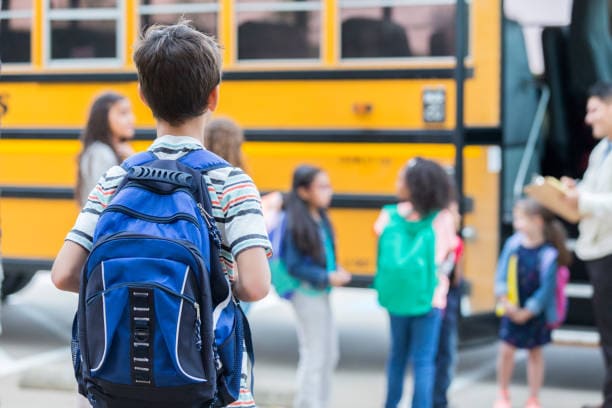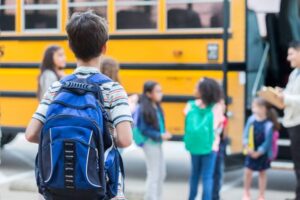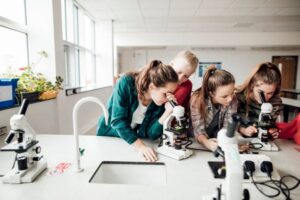What Will Teachers Carry Over From the Pandemic Into ‘Normal Times’?
Jennifer Orr is in her third decade of teaching elementary school students in the suburbs of Washington, D.C. She is a National Board Certified Teacher, mom to two teenagers, and an obsessive reader of books of all kinds:
Teaching through COVID, virtually, concurrently, and in person, was likely the most challenging period of my nearly 25 years of elementary school teaching. There is much about that time that I would like to forget and drop. Luckily, there are things that I want to hold on to. That period of time helped clarify some things that I really value.
While teaching third graders virtually, I built in places in our day for movement. We used GoNoodle, but any kind of way to get kids moving would work well. I knew that, in a virtual environment, my kids wouldn’t have the same opportunities to get up and move around as they have in our physical classroom. While also knowing that kids need to move! So I put GoNoodle breaks in throughout our day.
After we learned some of the options there, we added a new class job: Physical Trainer. Every day a different student serves as our Physical Trainer and chooses the GoNoodles we do. We still have set times throughout the day when we take those movement breaks, even as we’re back in person together. We also, just as we did in our virtual schooling, can opt for a break at other times if we’re feeling a need. Prioritizing the chances to move, dance, sing, and have some fun throughout our day, rather than just assuming those things will happen, is something I’m glad to have gained from that rough period.
Another concern I had in our virtual setting was how I would address any social and emotional issues with my students. I was worried that when I couldn’t really see them, only as faces in boxes on my screen, I wouldn’t be able to tell how they were doing. One way I addressed that, and it was a small band-aid for my concern, was to include check-ins every day. We did “On a Scale Of” (a grid of nine images of my dog or pandas or cartoon characters on which students share which one fits their feelings) or “Rose, Thorn, and Bud” (something good, something challenging, and something with potential in our lives) and others. These gave me some insight into how they were all doing while also having the bonus of building our classroom community. I used many of the same check-ins with my undergrads in a children’s literature course I teach. Every semester the check-ins are one of the most popular parts of our online class.
Neither the chance to move nor the check-ins are truly new to me. The challenges of COVID and virtual and concurrent schooling didn’t drastically change me as a teacher. Through it all, I did become more focused on the things I value and believe in. It has helped me do a better job of keeping my values at the forefront of the decisions I make in the classroom.
Luisana González is currently serving dual-language students in Illinois in a 5th grade classroom. She is in her 18th year of teaching and has previously taught K-5 MLs in a resource position, 2nd grade sheltered, and 2nd grade DL:
During the challenging times of pandemic teaching, I had to ask myself: What matters most? How will I use the time that is available for both synchronous and asynchronous learning? Perhaps what we need to remember the most about these times is that what we do with the instructional time that is available matters the most and is the cornerstone of effective instruction. The focus should not be placed on the limitations or challenges that exist but rather on what can be done to move forward to ensure student growth regardless of the circumstances.
Without doubt, the pandemic transformed teaching and learning in unprecedented ways. Nothing will ever be the same as it was in pre-pandemic times. While student learning loss or unfinished learning is a real concern for education, there are many positive things that came out of the less-than-ideal circumstances and these should be carried over to “normal times.”
I found that, while having to rely on technology to reach my students, it was more necessary than ever to share immediate, frequent, and specific feedback with them. This feedback was shared both through an individual virtual conference with a student, as well as through private messages in Google Meets. Students relied on frequent back-and-forth communication to monitor progress and get answers to their questions. Students also learned to message me through email and sign up for individual conferences in a Google spreadsheet or Google form. Many times students who were not comfortable asking questions or asking for extra support in front of the whole class were more apt and confident in doing these things privately via email or private message. I have definitely carried these practices over to in-person teaching and will continue to do so.
Additionally, I would like to continue offering the option for virtual parent-teacher conferences. It seemed far more convenient for many parents and they were often meeting with me from their place of work or without leaving their homes.
Since the pandemic, I have also implemented a flipped approach in the classroom and I continued to use this strategically during in-person teaching and have seen it be very effective and successful with my 5th grade students. Students would independently learn from brief videos that were either created by me or were carefully curated, and students could always access them in Google Classroom to view, review, and take notes. Furthermore, having a flipped classroom opened up the time for more collaborative learning and building deeper understanding. Flipped and blended learning will continue to be a part of my instructional plans. In order to take into account the challenges of remote learning and/or hybrid learning, my district adjusted the curriculum plans to allow for more time for teaching some units. This allowed me to target instruction and deepen understanding rather than feeling rushed to complete all of the units in a year’s time.
There should be a greater focus on the depth rather than the breadth of what is covered so that students have ample opportunities for guided and independent practice for both academic and social-emotional success in the classroom and beyond.
Fatima Baig, Ed.D. is a special education dual-language educator and a recent doctoral graduate from Drexel University’s School of Education, with additional degrees in early childhood, special education, and public administration:
The 2022-2023 school year marks the third year of the COVID-19 pandemic and, while each aspect of life has been uniquely challenged throughout these unprecedented times, one aspect of life and particularly teaching that has increased over the pandemic years is the level of compassion, understanding, and grace that teachers have for their colleagues and students. The nature of an educator is inherently compassionate. If you aren’t, well you just won’t make it too long in the field. However, the pandemic threw in a whole new level of compassion and grace that long-standing educators didn’t know they had within them. There were countless moments when I felt like walking away, especially when dealing with demanding parents and burnt out colleagues who took their frustrations out on me.
As a result of this overwhelming feeling amongst many professions, the nationwide push for mental health took lead. Despite district intentions to support teachers during the pandemic, their approach and impact was not representative of what educators needed for their mental health and in fact enraged us more than ever before because of the lack of relevancy. The pandemic called upon teachers who chose to stay in the classroom throughout the virtual, hybrid, and return to in-person learning journey to reflect deep within themselves and harness their greatest asset: compassion. Despite dealing with our personal experiences with the pandemic, we had to figure out a way to show up fully and authentically for our students.
To combat my increasingly stressful day-to-day, I started to practice meditation, mindfulness, and other different aspects of living a yogic lifestyle rooted in my ancestral lineage. Learning more about this new (for me) way of living allowed me to discover the power of mindful rest and compassion for all. I developed a morning routine that gave me time and mental space to breathe, process, and move so the energy within me can positively exuberate to those around me, which, as a teacher, is one of the most important characteristics to have since teachers set the tone for a class.
To be accommodating, accessible, and aware of various student needs is a best practice that most, if not all, educators are aware of and practice daily. However, without appropriate resources, time, and support, the to-do list can get overwhelming quickly. A helpful tool that I learned throughout the pandemic that I hope to continue in “normal” times is to develop my own healing and spiritual practice that will allow me to harness real compassion for those around me. This will allow me to show up authentically and level-headed for my students, colleagues, parents, and school leaders. I find it imperative for educators to discover and develop their own personal practice that gives them peace. Without a personalized practice that speaks to you, you’re bound to get lost in the demanding nature of the job, all while dealing with (or dismissing) the long-standing effects of the COVID-19 pandemic.
Kelly Owens is a literacy interventionist and past Teacher of the Year. She enjoys sparking educators’ professional reflections via her contributions to MiddleWeb, The King School Series (Townsend Press), and Emmy Award-winning “Classroom Close-up, NJ”:
Transitioning from virtual learning redirected the spotlight on students’ social-emotional needs. Fifth graders entering a new building could be rejoining in-person learning for the first time since 3rd grade. The socialization gap became a priority as children transitioned from sibling and family interactions to teacher and peer communications.
A graduate course once began class with time to jot to-do lists and anything else clogging our busy brains. It cleared minds of competition for our attention and made space available to learn. I wanted reacclimating students to have time for the opposite—adding positive thoughts. Establishing this mindset early could set the tone for the rest of class.
My students work with me due to past reading struggles. I hope they don’t enter class seeing themselves through that lens. They deserve a clean slate knowing they are in a place designed to grow foundational skills. Many middle graders are self-conscious and unmotivated. It’s important to help them let go of past struggles and develop positive mindsets.
An internet search for positivity ideas landed me at a Reading Horizons article called “One 2-Minute Task That Can Drastically Boost a Struggling Reader’s Success.” A quick skim of the piece introduced me to Shawn Achor and his work pairing positivity and potential. I was enticed to view his embedded TED Talks video “The Happy Secret to Better Work.” His pep talk immediately boosted my productivity!
Shawn’s entertaining unicorn story about twisting his childhood sibling squabble from a negative to a positive showed how every situation can be viewed from different angles. It aligns with my colleague Karen’s wisdom: “It’s all in how you package it.” Shawn’s research-based work connecting positive mindsets and success hit on two things my students really need. I was positive I wanted to introduce these strategies to my students to boost their productivity and self-esteem.
Extra palm-sized vocabulary notebooks transformed into Positivity Boost Journals. The tiny blank pages were perfect for two minutes of positive pictures, thankful thoughts, or delightful doodles. Students could write, draw, or muse about whatever happy and school-appropriate thoughts kickstarted their learning time in a positive light.
After a lesson introducing how to use mindful minutes to turn on learning centers of brains, Positivity Boost Journaling was locked into our regular routine. Animated hallway banter with buddies switched off as students crossed the classroom threshold and got lost in their positive thoughts. Relaxing instrumental music and, on bright sunny days, dimmed lights added to the relaxed vibe.
Starting 80-minute class periods with two minutes of positive thinking was a valuable investment into preparing students to be available and motivated to learn. It erased memories of missed catches in gym class, and a hard math test was bumped to the back burner. Intentionally filling our brains with positive thoughts before activities such as explicit phonics instruction stimulates evidence-backed success.




Leave a Reply